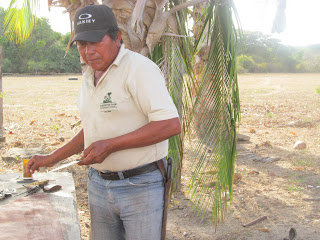Living on one of the most isolated ranches in the world, the Wapisiana workers have long crafted leather needs for their 150 horses and 3700 cattle using only their knives and home-made tools. You can imagine their excitement when leather tools arrived from the Rotary Club of Truro to work with the leather tanned on the ranch. Vaqueros (cowboys) patiently combined traditional skills with the new tools to create belts, key chains, bookmarks, knife holders and wallets.
CESO volunteer Allan Sorflaten prepared a business plan for the 5000 square kilometer Dadanawa Ranch located in Guyana,South America, Rotarian Lydia conducted a one week workshop in safe food handling for the Wapisiana kitchen and serving staff and followed up with a two week workshop in leather crafting. The participants then presented 'Miss Lydia' with a crafted belt of their own creation.When approaching the Rotary Club of Truro for funds with which to purchase leather working tools for the Dadanawa Ranch, Lydia really had no idea how appropriate the request was. We knew that on site there was a Tannery so there must be leather?
 |
| At the Tannery, Traditional Methods of Tanning are Used. |
Lydia worked with Ranch Business Development Manager Yolanda Vasconcellos in advance/on line to assess needs and also with Tandy Leather in Dartmouth to draft an order that would be appropriate. Basic tools were selected: a wooden mallet, a swivel knife,basic stamping edging tools,appropriate stamps including a cowboy, horse rider, cattle skull and dragon fly as well as two sets of letters plus rivets, key rings and belt buckles. An awl, leather punch, leather cutter and edger were included. The Leather Workshop was set and to our surprise, 17 interested people showed up! Their biggest question was: 'Are you taking the tools back to Canada with you?'
 |
| Cyril Is Dadanawa's Tanner. He made his hat from leather he tanned! |
Leather crafting has been an art passed from Father to Son on the Ranch for years. Practical needs have been met in past for all aspects of ranching: belts, knife sheaths, bull whips, horse saddles and ridingchapsbut interest in the new tools was high because the basic tools they have worked with have been mainly their knives,and rasps.
Prior to the first workshop, they selected hides, some thicker for belts (cow), some soft and thinner (calf and deer). Oswald, Ranch Foreman, was willing to cut belt lengths for our workshop. First he briefly soaked the end of the leather hide he was going to cut in water. Where he lives there is no running water so fetching water was his first task. I found his approach so interesting. He works on a self-made table in his yard so has no hesitation about securing the heavy leather hide by driving a nail into the wood! Next he measured the belt buckle he had chosen from what we brought (their favorites have been from Louis’ Second Hand store in Truro), set his divider to the right width, marked the belt width on the leather; then, taking his knife from his leather holder on his belt he sharpened the already sharp knife with the rasp, also on his belt in a leather holder! He skillfully proceeded to cut the belt perfectly straight full length of the hide. Precut belt lengths are very expensive through Tandy Leather, as are the good size buckles. Next Oswald took his hand carved wooden tool to put an edge on the belt.
 |
| Oswald, wearing the belt and cutlass holder he made, preparing to cut leather belt strips. |
 |
| Oswald shapes the and grooves the edge using a tool he carved from tropical wood. |
Before leaving home, we downloaded two ‘how to’ videos from Tandy Leather, where the tools were purchased. As an introduction, they watched the videos intently and were keen to proceed. We brought leather items we have collected over the years to give ideas: several styles of key chains, a bookmark, coasters, a hair clip and a little pouch. Elder Conrad said they had never had ideas like these to work with. They immediately went to work to cut these things out of their leather. The video had shown them how to stamp so creations began to emerge.
The basic leather making kit from Tandy Leather included several leather patterns. All patterns are to remain intact and patterns were traced and cut from recycled file folders we brought with us for that purpose.
One of the vaqueros bravely attempted wallet making. He carefully traced and cut out the four pattern pieces first from paper, then from calf’s skin. All pieces has to be hole-punched. You wouldn’t believe this aggressive vaquero would have such patience. All edges had to be laced together after stamping a delicate pattern. Then he made a second one!
It was great to see the enthusiasm which extended every possible day for the next two weeks.
















